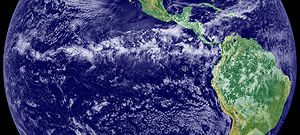Difference between revisions of "AY Honors/Weather - Advanced/Answer Key"
(minor) |
|||
| (5 intermediate revisions by the same user not shown) | |||
| Line 1: | Line 1: | ||
| − | [[Image: | + | [[Image:IntertropicalConvergenceZone-EO.jpg|right|300px|thumb|The thunderstorms of the Intertropical Convergence Zone form a line across the eastern Pacific Ocean.]] |
| − | |||
| − | + | The '''Intertropical Convergence Zone''' '''(ITCZ)''', also known as the '''Intertropical Front''' or the '''Equatorial Convergence Zone''', is a belt of [[low pressure area|low pressure]] girdling [[Earth]] at the [[equator]]. It is formed by the vertical ascent of warm, moist air from the latitudes above and below the equator. | |
| − | + | The air is drawn into the intertropical convergence zone by the action of the [[Hadley cell]], a [[scale (spatial)|macroscale]] [[earth's atmosphere|atmospheric]] feature which is part of the Earth's heat and moisture distribution system. It is transported aloft by the [[convection|convective]] activity of [[thunderstorm]]s; regions in the intertropical convergence zone receive [[precipitation (meteorology)|precipitation]] more than 200 days in a year. | |
| − | + | The location of the intertropical convergence zone varies over time, as it moves back and forth across the equator in a semiannual pattern, following the sun's [[zenith]] point. There is also a [[diel|diurnal]] cycle, with [[cumulus cloud|cumulus]] developing around midday and building to thunderstorms in mid to late afternoon. | |
| − | + | [[Image:Omega-500-july-era40-1979.png|thumb|right|Vertical velocity at 500 hPa, July average. Ascent (negative values) is a tracer for the ITCZ and is concentrated close to the solar equator; descent (positive values) is more diffuse.]] | |
| − | + | Variation in the location of the intertropical convergence zone drastically affects rainfall in many equatorial [[nation]]s, resulting in the wet and dry seasons of the tropics rather than the cold and warm seasons of higher latitudes. Longer term changes in the intertropical convergence zone can result in severe droughts or flooding in nearby areas. | |
| − | + | Within the ITCZ the average winds are slight, unlike the zones north and south of the equator where the trade winds feed in. Early sailors named this belt of calm '''the doldrums''' because of the low spirits they found themselves in after days of no wind. To find oneself becalmed in this region in a hot and muggy climate could mean death in the era when wind was the only motive force. | |
| − | |||
| − | + | Sometimes, a double ITCZ forms, with one located north and another south of the equator. When this occurs, a narrow ridge of high pressure forms between the two convergence zones, and usually, one or the other of the zones is stronger than the other. | |
| − | + | ==References== | |
| + | *[http://earthobservatory.nasa.gov/Newsroom/NewImages/images.php3?img_id=4028 Short NASA article with high resolution photo] | ||
| − | |||
| − | + | [[category:Tropical meteorology]] | |
| − | + | [[category:Atmospheric dynamics]] | |
| − | |||
| − | |||
| − | |||
| − | |||
| − | + | [[de:Innertropische Konvergenzzone]] | |
| − | + | [[es:Zona de convergencia intertropical]] | |
| − | + | [[fr:Zone de convergence intertropicale]] | |
| − | + | [[nl:Doldrum]] | |
| − | [[ | + | [[no:Den intertropiske konvergenssonen]] |
| − | [[ | + | [[nn:Den intertropiske konvergenssonen]] |
| − | + | [[pl:Tropikalna strefa konwergencji]] | |
| − | + | [[simple:Doldrums]] | |
| − | [[ | + | [[fi:Pasaatituulten kohtaamisvyöhyke]] |
| − | [[ | + | [[sv:Intertropiska konvergenszonen]] |
Revision as of 15:21, 18 May 2006
The Intertropical Convergence Zone (ITCZ), also known as the Intertropical Front or the Equatorial Convergence Zone, is a belt of low pressure girdling Earth at the equator. It is formed by the vertical ascent of warm, moist air from the latitudes above and below the equator.
The air is drawn into the intertropical convergence zone by the action of the Hadley cell, a macroscale atmospheric feature which is part of the Earth's heat and moisture distribution system. It is transported aloft by the convective activity of thunderstorms; regions in the intertropical convergence zone receive precipitation more than 200 days in a year.
The location of the intertropical convergence zone varies over time, as it moves back and forth across the equator in a semiannual pattern, following the sun's zenith point. There is also a diurnal cycle, with cumulus developing around midday and building to thunderstorms in mid to late afternoon.
Variation in the location of the intertropical convergence zone drastically affects rainfall in many equatorial nations, resulting in the wet and dry seasons of the tropics rather than the cold and warm seasons of higher latitudes. Longer term changes in the intertropical convergence zone can result in severe droughts or flooding in nearby areas.
Within the ITCZ the average winds are slight, unlike the zones north and south of the equator where the trade winds feed in. Early sailors named this belt of calm the doldrums because of the low spirits they found themselves in after days of no wind. To find oneself becalmed in this region in a hot and muggy climate could mean death in the era when wind was the only motive force.
Sometimes, a double ITCZ forms, with one located north and another south of the equator. When this occurs, a narrow ridge of high pressure forms between the two convergence zones, and usually, one or the other of the zones is stronger than the other.
References
de:Innertropische Konvergenzzone es:Zona de convergencia intertropical fr:Zone de convergence intertropicale nl:Doldrum no:Den intertropiske konvergenssonen nn:Den intertropiske konvergenssonen pl:Tropikalna strefa konwergencji simple:Doldrums fi:Pasaatituulten kohtaamisvyöhyke sv:Intertropiska konvergenszonen


